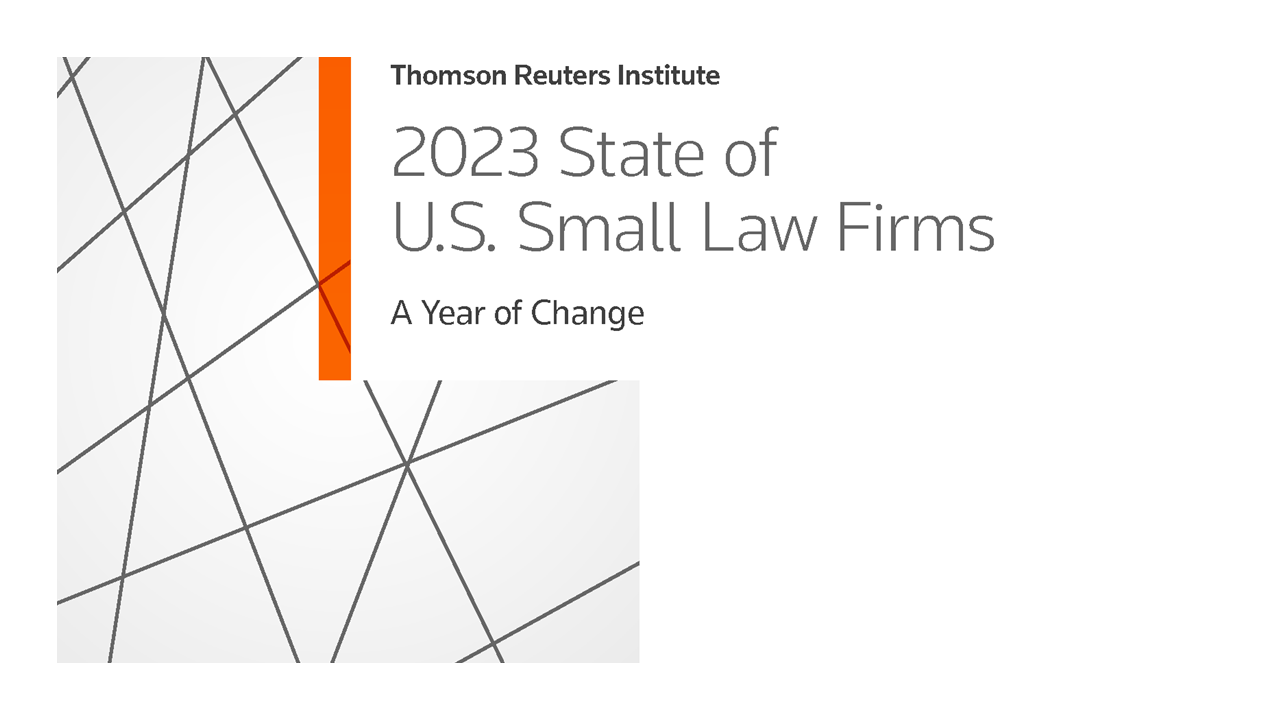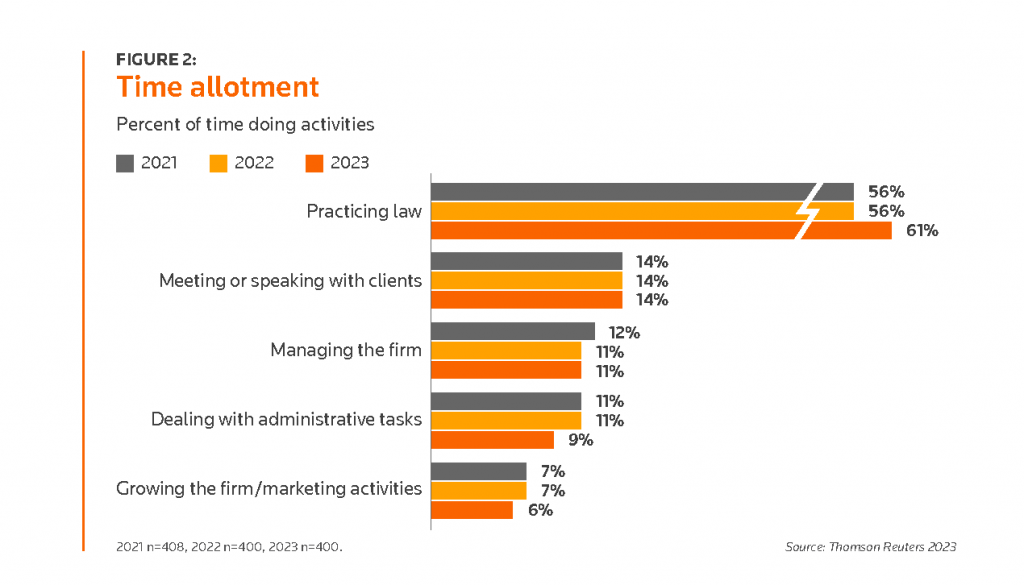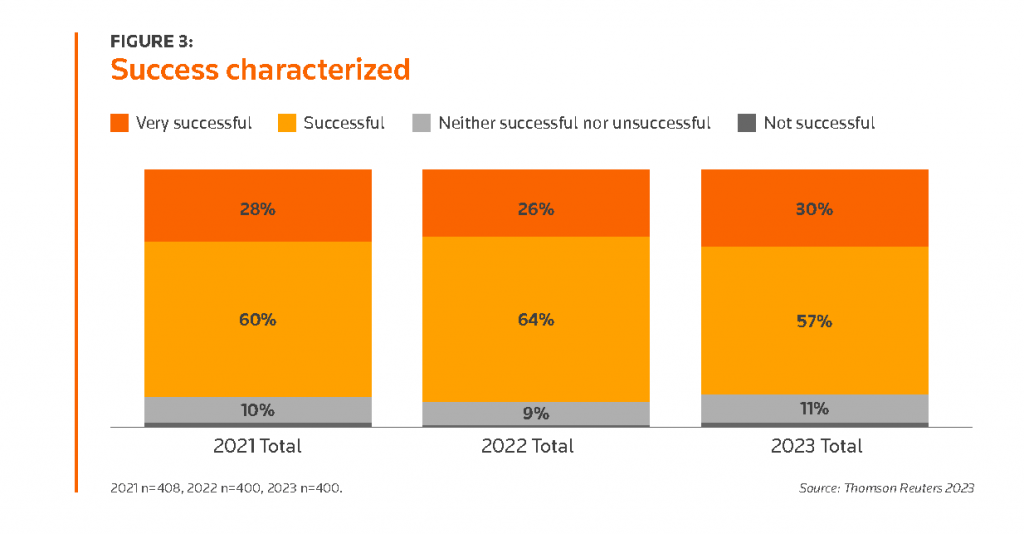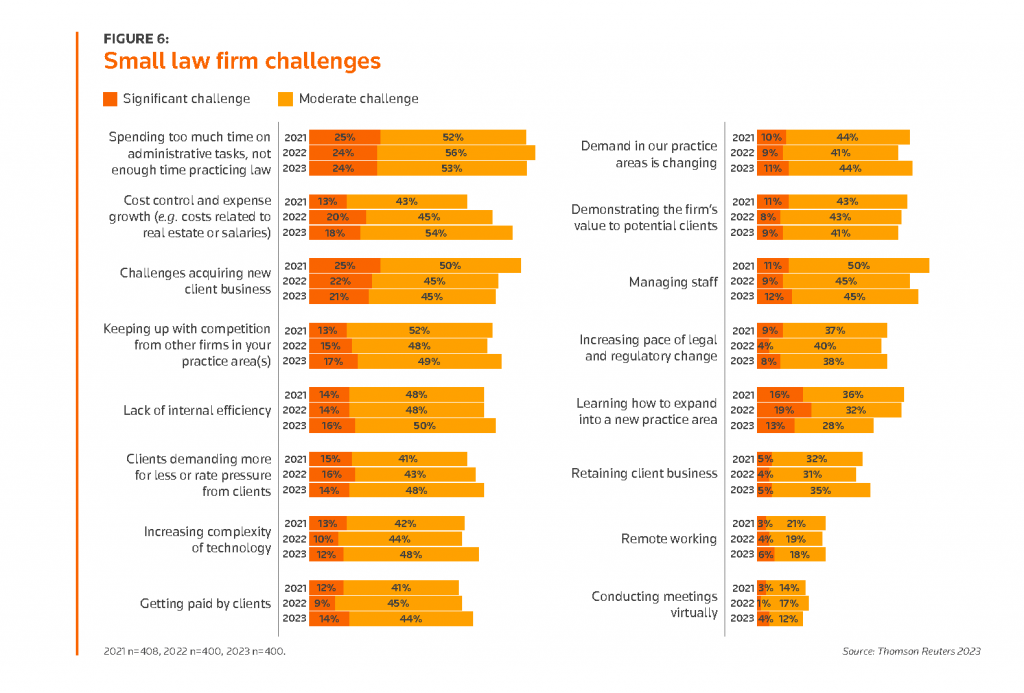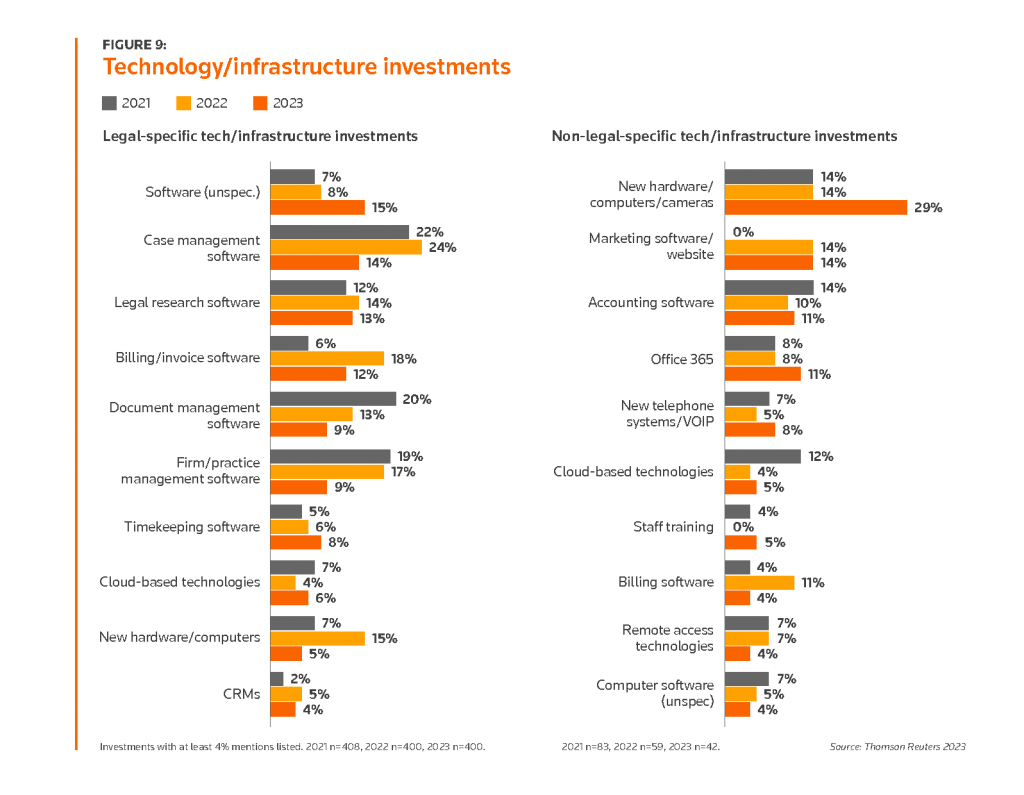Seven times since 2016, Thomson Reuters has conducted a survey on the state of small law firms in the U.S., and every time, it found that small firms had made virtually no progress on one of their greatest challenges, which is that they spend too much time on administrative tasks to the exclusion of practicing law.
As Thomson Reuters itself says, “Previous editions have frequently been a case of ‘the more things change, the more things stay the same.'”
But this year, in the just-released eighth edition of the State of U.S. Small Law Firms report from the Thomson Reuters Institute, the survey shows — at long last — some progress among firms of 29 or fewer lawyers. This year, the percentage of time small firm lawyers spend practicing law went up from 56% (where it had stayed for two years) to 61%.
“Small firm lawyers may have finally broken out of the recurring, frustrating pattern we’ve seen in previous years in which they have struggled to devote more time to practicing law and less time to dealing with administrative tasks,” the report says. “This is understandably of critical importance because it is literally how small firms and their lawyers make their money.”
While the increase of five percentage points may not seem significant, the report notes that, over the course of a year, that could equate to roughly 150 additional billable hours or more.
Measures of Success
Accompanying that increase in time spent practicing law is an increase in the percentage of lawyers who consider their firms “very successful.” Last year, 26% of lawyers characterized their firms that way, but this year, that rose to 30%.
However, the number of lawyers who view their firm as “successful” dropped, from 64% to 57%, and the number who consider themselves “neither successful nor unsuccessful” rose from 9% to 11%.
Of course, that begs the question of how firms define success. Here again, the primary ways that firms measure their success has not changed over the years of this survey. Among the primary measures of success:
- Overall profits (27%).
- Client satisfaction ratings (24%).
- Overall revenues (16%).
- Work/life balance (15%).
- Repeat business (9%).
- Profits per partner (3%).
Challenge Controlling Costs
Even as the survey has found progress among smaller firms in addressing the challenge of time spent on administrative tasks, it found an increasing number of lawyers citing a new challenge: that of controlling costs and expenses.
Two years ago in the survey, just 56% of firms cited cost control as either a significant or moderate challenge. This year, that number rose to 72%. That makes it the second-highest challenge lawyers in this year’s survey say they face, behind the perennial need to reduce time on administrative tasks.
Higher Billing Rates, More Tech
What changes have small firms made during this period that may have driven these changing perceptions? Turns out, the most significant change firms have made over the last three years has been to increase their billing rates.
In 2021, less than half of small firms increased billing rates, the survey says. In 2022, the number rose to 59%. It rose again this year to 64%, meaning that nearly two-thirds of small firms increased their rates.
The next most common change among small firms was to adopt new technology. This year, 42% of firms adopted new technology, compared to 41% last year and 50% in 2021.
In buying new technology, lawyers cited among their top needs software for case management, legal research and billing and invoicing.
Little Use of Generative AI
One type of technology small firms are not yet heavily investing in is generative AI. The survey, which was conducted during August, found that 72% of small firm lawyers have heard of generative AI but have not used it. Just over a quarter say they do no fully understand generative AI. Ten percent had never heard of generative AI.
So far, small firm lawyers also do not see AI as a threat to their practices, the report says. Fewer than 15% believe it represents a major threat even three years from now, and over the next year, 85% believe it poses only a minimal threat or none at all.
Still, some 40% of lawyers in small firms believe generative AI presents either a major or a minor opportunity to automate processes within their practices. Thirty-five percent say it does not present such an opportunity, and a quarter are unsure.
“While much uncertainty remains, we are increasingly confident of one thing: whether one believes AI represents an opportunity or a threat, they are likely both right,” the report concludes.
“Anyone viewing AI as an opportunity will be more likely to undertake a deeper exploration of its increasing capabilities and spot new avenues for adoption and even revenue generation. Those who view it as a threat are more likely to avoid it and risk falling behind the market.”
Stepping Up Marketing
One area where small firms have stepped up their game is in marketing, the report finds. In 2021, 84% of firms said they were currently conducting marketing or advertising campaigns. This year, that rose to 93%. At the same time, the number of firms spending 3% or more of their budget on marketing rose from 52% to 60%.
Where are firms spending their marketing dollars? The most common marketing spend (63%) is for “networking” — which the report does not define.
Far fewer firms say they are spending money on other forms of marketing, such as social media marketing (38%), search engine optimization (38%), free listings in online directories (31%), blogging and e-bulletins (30%), and video marketing (8%).
A Cautionary Note
The report ends on a cautionary note.
While small law firms have been able this year to “move the needle” and make meaningful progress on their long-standing top goal of spending more time practicing law and less time on administrative tasks, they cannot rest on their laurels, especially in the face of the rapid advancement of AI and constantly changing client expectations.
“It is of critical importance that small firms hold on to their hard-won gains this year in spending more time practicing law and less time dealing with administrative tasks. Avoiding backsliding into previous habits or losing focus because of distractions or shifting attention to other goals will be key.”
LawSites Coverage of Past years of the survey:
2022 Survey
2020 Survey
2019 Survey
2017 Survey
- Exclusive: First Look At New Survey Of Solo And Small Firms.
- Solo and Small Firms Face Many Challenges, Survey Shows, But Few Have Made Changes to Address Them.
2016 Survey
- This Week In Legal Tech: Exclusive Results Of A New Small-Firm Survey.
- Exclusive Survey Results: Small Firms’ Greatest Challenges And What They’re Doing To Address Them.
- More Exclusive Survey Results: How Small Law Firms Measure Success.
- More Exclusive Survey Results: Few Small Firms Implementing New Technology.
- This Week In Legal Tech: Survey Sheds Light On How Solos Differ.
 Robert Ambrogi Blog
Robert Ambrogi Blog